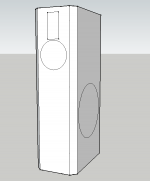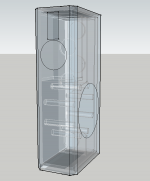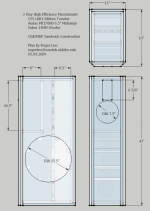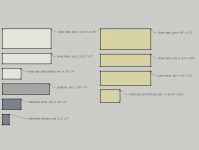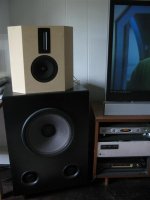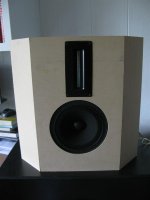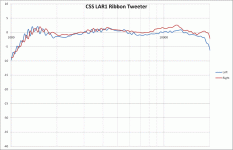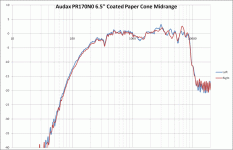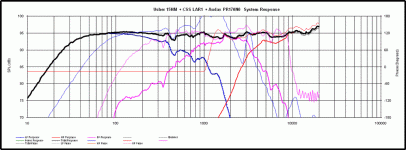Hey All,
The weather is finally starting to get nice up here in the northwest which means it is time to start building speakers. I'm getting ready revise my 3 way actives. Currently they are loosely based on the Linkwitz Pluto; in that they use the NSW2 and are fairly omnidirectional. They have Usher 15HMs on the bottom up to 350Hz, and Dynavox 5.25" polycones up to 1000Hz. The bass is great and they have a very wide sweet spot thanks to the polar response, but I've come to the conclusion that their top end is lacking something and the midrange doesn't grab me nearly as much as a set of 2 ways I have with BG Neo8PDRs powered by a Sonic Impact 5066.
My primary goals are higher efficiency, better dynamics, high end frequency extension (compared to what I have now), and compactness (again, comparatively). I'm not going for 120dB, but I want the efficiency so I can use higher quality amps that are easier on my pocket book. Right now I have a NAD 304 up top and a Pioneer SX-6 in the middle. The NAD 304 is listenable, the SX-6 isn't so hot, even between 350Hz and 1000Hz. I'm probably going to build some 41Hz tripaths and keep my Pioneer SX-1050 (120 w, ~60lb) on the bottom.
I've already got the drivers sourced. The Usher 15HMs will continue their bass service. They are going in a 2.7 ft^3 sealed enclosures (qtc=~.7) and will be eq'd to an F3 of 35Hz (12db Shelf, which is why I'm keeping the SX-1050 on the bottom). In the future I plan on having real subs, but in the short term the Ushers have plenty of displacement for my needs/room. They will still do 100db at 30HZ without room boost on paper with 128 watts. That isn't so shabby.? Some of you are laughing smugly now, that's ok.
For the midrange I bought a pair of Audax PR170N0s from madisound. They are a coated version of the PR170M0s. They are a bit of gamble, but the response plot just looked to pretty to pass up. I plan on putting them in a sealed enclosure and crossing them at 350Hz 4th order. Since I'm not going for 120db they should be fine even with their .5mm xmax. If anyone is actually bothering to read this they are probably wondering why I'm not going open baffle. Well, I'd love to but SAF and room placement dictate against it.
For the top end, Bob from CSS gave me a bit of a deal on a pair of their new LAR1 ribbon tweeters. They have a honeycomb foils which are suppose to reduce distortion. I choose them for their efficiency and hopefully dynamics (I haven't got to play with them enough to judge their dynamics). My initial plan is to cross them rather high as the PR170N0s don't seem to have any harsh breakup modes. Hopefully next week I'll have time to mount the ribbons and the mids on open baffles temporarily so I can play with them more before I start the final enclosures.
For SAF I'm planning on building them as narrow floorstanding towers with the woofers side mounted. I can use my DCX2496 for time alignment. I've measured them at 90 degrees and tested them in my listening room and they seem to work fine that way (they actually seem better to tell you the true, possibly because they are farther from the rear wall). Dimensions will be 12" wide, 43" high, and 19" deep. All walls will be 1.5", the cabs will weigh about 130lb without drivers. I was going to use OSB/MDF sandwich construction, but there was a lot of wasted material so I'm going all MDF. It'll take 3 sheet of 3/4" to build both cabs.
In the long term I wouldn't mind retiring my DCX2496 but in the short term I need it at least for time alignment and bass eq. Any thouhts or Suggestions are welcome, there are still some things that are up in the air.
Here's a rendering:
The weather is finally starting to get nice up here in the northwest which means it is time to start building speakers. I'm getting ready revise my 3 way actives. Currently they are loosely based on the Linkwitz Pluto; in that they use the NSW2 and are fairly omnidirectional. They have Usher 15HMs on the bottom up to 350Hz, and Dynavox 5.25" polycones up to 1000Hz. The bass is great and they have a very wide sweet spot thanks to the polar response, but I've come to the conclusion that their top end is lacking something and the midrange doesn't grab me nearly as much as a set of 2 ways I have with BG Neo8PDRs powered by a Sonic Impact 5066.
My primary goals are higher efficiency, better dynamics, high end frequency extension (compared to what I have now), and compactness (again, comparatively). I'm not going for 120dB, but I want the efficiency so I can use higher quality amps that are easier on my pocket book. Right now I have a NAD 304 up top and a Pioneer SX-6 in the middle. The NAD 304 is listenable, the SX-6 isn't so hot, even between 350Hz and 1000Hz. I'm probably going to build some 41Hz tripaths and keep my Pioneer SX-1050 (120 w, ~60lb) on the bottom.
I've already got the drivers sourced. The Usher 15HMs will continue their bass service. They are going in a 2.7 ft^3 sealed enclosures (qtc=~.7) and will be eq'd to an F3 of 35Hz (12db Shelf, which is why I'm keeping the SX-1050 on the bottom). In the future I plan on having real subs, but in the short term the Ushers have plenty of displacement for my needs/room. They will still do 100db at 30HZ without room boost on paper with 128 watts. That isn't so shabby.? Some of you are laughing smugly now, that's ok.
For the midrange I bought a pair of Audax PR170N0s from madisound. They are a coated version of the PR170M0s. They are a bit of gamble, but the response plot just looked to pretty to pass up. I plan on putting them in a sealed enclosure and crossing them at 350Hz 4th order. Since I'm not going for 120db they should be fine even with their .5mm xmax. If anyone is actually bothering to read this they are probably wondering why I'm not going open baffle. Well, I'd love to but SAF and room placement dictate against it.
For the top end, Bob from CSS gave me a bit of a deal on a pair of their new LAR1 ribbon tweeters. They have a honeycomb foils which are suppose to reduce distortion. I choose them for their efficiency and hopefully dynamics (I haven't got to play with them enough to judge their dynamics). My initial plan is to cross them rather high as the PR170N0s don't seem to have any harsh breakup modes. Hopefully next week I'll have time to mount the ribbons and the mids on open baffles temporarily so I can play with them more before I start the final enclosures.
For SAF I'm planning on building them as narrow floorstanding towers with the woofers side mounted. I can use my DCX2496 for time alignment. I've measured them at 90 degrees and tested them in my listening room and they seem to work fine that way (they actually seem better to tell you the true, possibly because they are farther from the rear wall). Dimensions will be 12" wide, 43" high, and 19" deep. All walls will be 1.5", the cabs will weigh about 130lb without drivers. I was going to use OSB/MDF sandwich construction, but there was a lot of wasted material so I'm going all MDF. It'll take 3 sheet of 3/4" to build both cabs.
In the long term I wouldn't mind retiring my DCX2496 but in the short term I need it at least for time alignment and bass eq. Any thouhts or Suggestions are welcome, there are still some things that are up in the air.
Here's a rendering:
Attachments
So I found some time to build router jigs and temporary open baffles for the LAR1 and the PR170N0. They are 17.75" tall and 18" wide. The main panel is 11" wide and there are 5" wings at 45 degrees on either side. See picture below. Currently I'm using crossover points at 500 Hz and 5kHz (all LR24) and set levels at listening position using 1/6th octave smoothing. The vertical dispersion of the tweeter doesn't seem to be an issue. It is actually much better than I anticipated. The mids had a terrible hiss with my SX-6 so I swapped it out for the NAD 304 which proved to be much quieter, and am using my 25 watt TDA7265 chipamp for the Ribbons. Below are some of the initial nearfield measurements I made on the LAR1 and PR170N0.
My measurement setup consists of Behringer ECM 8000 microphone, Behringer DSP110 Shark microphone preamplifier, Echo Indigo I/O PCMCIA soundcard, TDA7265 chipamp, and SynRTA. I exported the data to csv files from SynRTA and plotted them in Excel with no smoothing. The Indigo I/O isn't super clean. Loopback shows .5 dB hysteresis all the way across the frequency band. I also don't trust the LF response it is reporting. It is showing a strong rolloff at 100 Hz with my Ushers which is inconsistent with measurements I made with my EMU-0202.
My measurement setup consists of Behringer ECM 8000 microphone, Behringer DSP110 Shark microphone preamplifier, Echo Indigo I/O PCMCIA soundcard, TDA7265 chipamp, and SynRTA. I exported the data to csv files from SynRTA and plotted them in Excel with no smoothing. The Indigo I/O isn't super clean. Loopback shows .5 dB hysteresis all the way across the frequency band. I also don't trust the LF response it is reporting. It is showing a strong rolloff at 100 Hz with my Ushers which is inconsistent with measurements I made with my EMU-0202.
Attachments
LAR1 nearfield measurements. I was pleasantly surprised with how closely the frequency responses matches with their datasheet. The datasheet can be found here:http://www.creativesound.ca/details.php?model=LAR1
Attachments
My plan is to live with these for a week or two. Pretty soon I'm going to break down and buy a Smith and Larson WT2 so I can get T/S and impedance measures. I'm also tempted to throw the PR170N0s in sealed or aperiodic boxes to see how much of "the magic" is lost before I spend the time and $$$ building final cabinets.
Nice combo of drivers you have, can you tell a little info on your LAT ribbon,
1. Min x-over point
2. max spl
3. you impression of this driver.
cheers
1. Min x-over point
2. max spl
3. you impression of this driver.
cheers
thanks.
I haven't had them long enough to get a really good feel for them, but I can say you have to choose between 1 and 2.
At 2.5kHz (LR12) the treble can get really harsh at higher volumes and the mid range starts to sound hollow, but it might be fine in a mini monitor arrangement. At low/moderate volume levels vocal timbres actually sound quite detailed and neutral.
Crossed at 5kHz (LR24) they have no problem keeping up with the Audax in terms of SPL. Currently, I've brought the crossover back to 3.4 kHz because at 5 kHz the sound stage is larger but the mid range is somewhat smeared. My open baffle arrangement is far from ideal. I don't know as of yet how 3.4 copes with really high SPL.
Together they sound quite dynamic and clean. They do offer something silk domes don't in terms of dynamics. I don't have a good enough feel to tell you what part of this is attributable to the Audax and which is attributable to the LAR1. Additionally the amount of dipole radiation covaries with where the crossover point is set which influences the sound stage characteristics and further confound my observations. Headroom is scary. My 15s quickly become the weak link on bass heavy tracks.
I haven't had them long enough to get a really good feel for them, but I can say you have to choose between 1 and 2.
At 2.5kHz (LR12) the treble can get really harsh at higher volumes and the mid range starts to sound hollow, but it might be fine in a mini monitor arrangement. At low/moderate volume levels vocal timbres actually sound quite detailed and neutral.
Crossed at 5kHz (LR24) they have no problem keeping up with the Audax in terms of SPL. Currently, I've brought the crossover back to 3.4 kHz because at 5 kHz the sound stage is larger but the mid range is somewhat smeared. My open baffle arrangement is far from ideal. I don't know as of yet how 3.4 copes with really high SPL.
Together they sound quite dynamic and clean. They do offer something silk domes don't in terms of dynamics. I don't have a good enough feel to tell you what part of this is attributable to the Audax and which is attributable to the LAR1. Additionally the amount of dipole radiation covaries with where the crossover point is set which influences the sound stage characteristics and further confound my observations. Headroom is scary. My 15s quickly become the weak link on bass heavy tracks.
roger_lew said:thanks.
I haven't had them long enough to get a really good feel for them, but I can say you have to choose between 1 and 2.
At 2.5kHz (LR12) the treble can get really harsh at higher volumes and the mid range starts to sound hollow, but it might be fine in a mini monitor arrangement. At low/moderate volume levels vocal timbres actually sound quite detailed and neutral.
Crossed at 5kHz (LR24) they have no problem keeping up with the Audax in terms of SPL. Currently, I've brought the crossover back to 3.4 kHz because at 5 kHz the sound stage is larger but the mid range is somewhat smeared. My open baffle arrangement is far from ideal. I don't know as of yet how 3.4 copes with really high SPL.
Together they sound quite dynamic and clean. They do offer something silk domes don't in terms of dynamics. I don't have a good enough feel to tell you what part of this is attributable to the Audax and which is attributable to the LAR1. Additionally the amount of dipole radiation covaries with where the crossover point is set which influences the sound stage characteristics and further confound my observations. Headroom is scary. My 15s quickly become the weak link on bass heavy tracks.
There are not many ribbon that can cross below 2.5Khz. Fortunately Audax can cross higher than that.
Interesting build!
I have Neopro5i, PHL1120, TD12S 3-way active build using the DCX2496.
I was always curious about the Audax mid-range driver. I will follow your build.
I have Neopro5i, PHL1120, TD12S 3-way active build using the DCX2496.
I was always curious about the Audax mid-range driver. I will follow your build.
There are not many ribbon that can cross below 2.5Khz. Fortunately Audax can cross higher than that.
Yep, for this application it isn't a problem. I think they could work well crossed lower with a nice midwoofer if high SPL isn't called for. I always intended to cross it rather high. I still need to try letting the Audax run open on the top and filling in with the ribbon.
I have Neopro5i, PHL1120, TD12S 3-way active build using the DCX2496.
Cool, Are going open baffle?
I definitely considered those, but choose the LAR1 because it is a true ribbon and less than half the cost of the Neopro5i. I choose the Audax over the PHL because it had better looking FR, slightly better sensitivity, and was about half the price.
Of course the downside is that your combo will probably be able to play much louder. 😀
PHL 1120 Measurements
This site has PHL 1120 measurements if anyone from the internets stumbles here looking for them:
http://www.audioheuristics.org/measurements/Testing/PHL1120/PHL1120.htm
This site has PHL 1120 measurements if anyone from the internets stumbles here looking for them:
http://www.audioheuristics.org/measurements/Testing/PHL1120/PHL1120.htm
roger_lew said:
Yep, for this application it isn't a problem. I think they could work well crossed lower with a nice midwoofer if high SPL isn't called for. I always intended to cross it rather high. I still need to try letting the Audax run open on the top and filling in with the ribbon.
Cool, Are going open baffle?
I definitely considered those, but choose the LAR1 because it is a true ribbon and less than half the cost of the Neopro5i. I choose the Audax over the PHL because it had better looking FR, slightly better sensitivity, and was about half the price.
Of course the downside is that your combo will probably be able to play much louder. 😀
No open baffle for me, all sealed...Im not good enough yet to figure out all the open baffle stuff.
I have the PHL1120 and the B&C 6MD38 (its a drop in replacement so far for less $$).
The Neopro5i isnt has great as the more expensive RAAL ribbons but its still performs very well down to 2K Hz when using the nice steep slopes in the DCX
I look forward to your results because its nice to have great performance for 1/2 the $$$.
I don't have PHL 1120, but I just bought a 2nd hand PHL2460, a 8" mid range/bas driver with Fs=80Hz.
It does sound quite good, even when compared to Usher 8945.
It does sound quite good, even when compared to Usher 8945.
So I spent last weekend playing with Jeff Bagby's Passive Crossover Designer. The Audax seem to work better crossed higher than I was originally intending so I'm going to scrap the side mounted woofer enclosure and build more a traditional 3 way with a passive crossover and Linkwitz Transform. I haven't drawn up a box yet but it will modeled after the Harbeth 40.1s. Stands will bring the mid to ear height.
I thought about having an active low pass for the woofers to avoid buying big caps and inductors, but going full passive will give me more flexibility with amplifiers. If I go active on the bottom I will always have to bi-amp. If I'm fully passive I have the option of using a single amp, bi-amping, or tri-amping.
The summed response generated from the passive crossover is attached below approximates LR2 slopes @ 650 Hz between the woofer and mid, and LR4 slopes @ 3500 between the mid and tweeter. On the component side this translates to a 2nd order LP on the woofer, a 1st order HP and 2nd order LP on the mid, and a 4th order HP on the tweeter. The attached PDf also simulates a Linkwitz Transform with about 15 dB of boost. Fp = 30, Qp = .707. I also have a PDF of the spreadsheet but it is over 100kb so I can't post it here. Let me know if your interested.
15dB of boost might sound extreme but in practice I'm still only using a fraction of a watt at normal listening volume because the woofers are so efficient to begin with (my cheap multimeter reports 0-2 hundreds across the terminals). The sound quality is much better with LT than the ported alternative (6.5 ft^3 tuned to 35Hz).
I thought about having an active low pass for the woofers to avoid buying big caps and inductors, but going full passive will give me more flexibility with amplifiers. If I go active on the bottom I will always have to bi-amp. If I'm fully passive I have the option of using a single amp, bi-amping, or tri-amping.
The summed response generated from the passive crossover is attached below approximates LR2 slopes @ 650 Hz between the woofer and mid, and LR4 slopes @ 3500 between the mid and tweeter. On the component side this translates to a 2nd order LP on the woofer, a 1st order HP and 2nd order LP on the mid, and a 4th order HP on the tweeter. The attached PDf also simulates a Linkwitz Transform with about 15 dB of boost. Fp = 30, Qp = .707. I also have a PDF of the spreadsheet but it is over 100kb so I can't post it here. Let me know if your interested.
15dB of boost might sound extreme but in practice I'm still only using a fraction of a watt at normal listening volume because the woofers are so efficient to begin with (my cheap multimeter reports 0-2 hundreds across the terminals). The sound quality is much better with LT than the ported alternative (6.5 ft^3 tuned to 35Hz).
Attachments
- Status
- Not open for further replies.
- Home
- Loudspeakers
- Multi-Way
- CSS LAR1 Ribbon, Audax PR170N0, Usher 15HM
